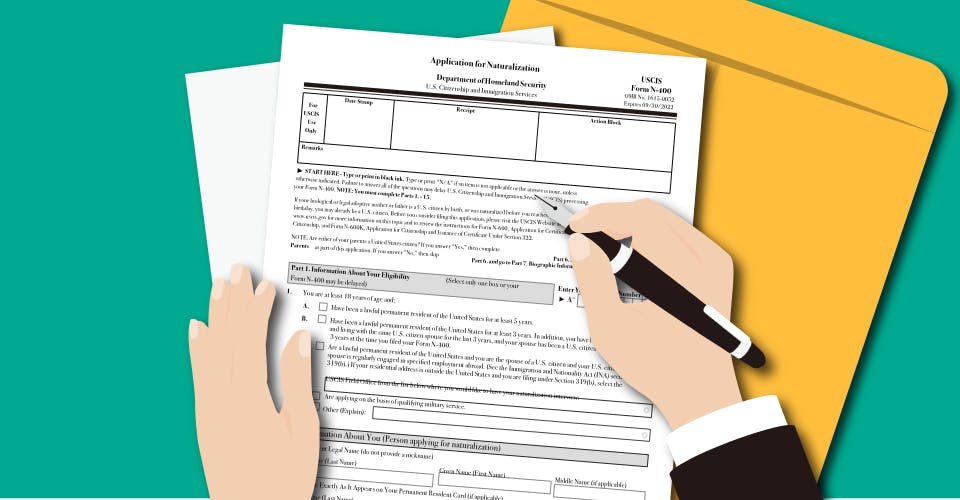Before Filling Out the Form
To begin the filing, you’ll need to access the Form N-400 on the USCIS Website. Bring up the PDF copy and begin filling out the form online; we also offer the sample form for your reference. You can also print the form and fill out by hand if needed. Ready? Let's go!
Part I: Information about Your Eligibility
This is perhaps the most important section of the form because it dictates how an applicant will proceed with the rest of the sections in the application.
Notes:
- Applying as a lawful permanent resident means you are not married and you have lived in the U.S. continuously for the 5 years immediately preceding the date you file Form N-400.
- If you are married to a U.S. citizen, you may begin filing your N-400 Form after 3 years of lawful permanent residence in the United States
- Individuals with qualifying armed service, please visit the USCIS.gov/military for more information.
Part II: Applicant Information
Questions 1-2 pertain to your name. Your official name on your birth certificate might be slightly different than the name on your green card (because a middle name is often omitted on the green card). Make sure to fill in each question accordingly.
Question 3 is regarding a maiden name. Enter if applicable. Question 4 asks applicants if they would like to change their name legally at the time of their oath ceremony. In order to avoid confusion or extra paperwork, it is a good idea to keep your name the same.
Question 5 asks applicants to enter their social security number.
Question 6 asks for the applicant’s USCIS online account number. Unless the applicant has ever electronically submitted a benefits request to USCIS, such as Form I-90, Application to Replace Permanent Resident Card, he/she will not have a USCIS online account number.
Questions 10-13 pertain to an applicant’s nationality (where they are presently a citizen) and where they were born. Applicants must answer the country where they were born even if doesn’t exist anymore (i.e. Yugoslavia). Question 12 asks applicants to specify if they are trying to waive the English and/or Civics test based on a disability. Question 13 is regarding exemption from the English Language Test based on how old they are/how long they have been living in the U.S. Applicants who are over the age of 55 and lived in the U.S. for 15 years qualify, as do applicants who are over the age of 50 and have lived in the U.S.
Notes:
Applicants applying for such waivers should submit Form N-648, Medical Certification for Disability Exceptions, as an attachment to their naturalization application
Part III: Accommodations for Individuals with Disabilities and/or Impairments
This section pertains to individuals who have a disability. Question 1 asks the applicant if he/she is requesting an accommodation to the naturalization process because of a disability.
If the applicant selects “Yes” to Item 1, he should select the box for all applicable disabilities for which he is seeking accommodation (Boxes A, B, and/or C). It is often best to submit a letter from a doctor verifying the applicant’s disability and the need for the accommodation.
Part IV: Information to Contact you
This section is simply for the applicant to provide as much information about their home address, work/home/mobile phone numbers, and email addresses (current). If an individual is hearing impaired, they need to write “TTD” after their telephone number. Be sure to include area codes.
Part V. Information about Your Residence
The residence section of the application is critical for case management. The USCIS rule of 3-5 year residence depending on marriage or single status remains, and individuals filing their N-400 need to prove their residency once more on this form. Residence means continuous residence, and as such the adjudicator will ask the applicant at his/her interview about any gaps in the information they provide here.
Notes:
- For travel outside of the U.S., try to find receipts of airline tickets if you cannot remember the exact dates of travel. Or, if it is not possible to find such receipts, simply electronically mark the form on the first day of the month, i.e. “10/01/2016”
- If an applicant lists a residence that is not within the United States, you should consider this a red flag and consult the ILRC’s naturalization manual or an expert on the subject.
Part VI. Information About Your Parents
In this section, questions pertain to the applicant's parents. It might be the case that the applicant is already a U.S. citizen without knowing it. If neither parent is a U.S. citizen, the applicant can skip this section and move on to Part VII.
Notes:
If even one of the applicant’s parents is a U.S. citizen, it is possible that the applicant is already a U.S. citizen too. For example, the new questions ask whether the applicant’s biological or legally adoptive mother or father is a citizen by birth or naturalized before the applicant’s 18th birthday.
Part VII. Biographic Information
This section will help the USCIS check an applicant’s criminal record, which is Section of the good moral character portion of the naturalization process.
For questions 3-6, the applicant may use the information on their Drivers License or other Identification Card.
Notes:
The applicant must list his height in feet and inches, not in meters or centimeters. Correspondingly, the applicant’s weight should be entered in pounds, not in kilograms.
Part VIII. Information about your Employment and Schools/Universities Attended
This section pertains to the applicants' employment and education over the past 3-5 years. If
the applicant is a homemaker, she should write “homemaker” as a job. If the applicant works for herself, she should write “self-employed.” If an applicant has been unemployed for a gap in the past 3-5 years, they should be honest in this section about their time without work in the United States.
Notes:
If the applicant received public benefits by fraud or by lying, USCIS might deny the applicant for failing to show good moral character. In some USCIS cases, USCIS policy is to confirm that the applicant received public benefits appropriately, such as Supplemental Security Income (SSI).
Part IX. Time Spent Outside the United States
In this section, the USCIS is once again trying to confirm that the applicant has had continuous residence in the United States for the past 3-5 years. Trips to Canada and Mexico are outside of the U.S.
If the applicant left the U.S. for more than six months or moved to another country after obtaining residency in the U.S., these are red flags and the applicant should talk with an experienced immigration expert to decide how to proceed with their case.
In addition, if an applicant was taking frequent trips of short duration outside of the U.S. during their declared residency in the United States, the Immigrant Legal Resource Center (ILRC) recommends they attach a written note to their application stating the nature and reason for the trips.
Part X. Information about Your Marital History
If an applicant is single and has never been married, he/she only needs to complete the first question in this section and then move onto Part XI.
If the applicant is applying as the spouse of a U.S. citizen (1b and 1c), she must check that his/her marital status is “married.” An applicant who is married needs to complete Part X.
Note:
- The N-400 form includes “separated” as an option for applicants to indicate their current marital status. In this context “separated” means legally separated.
- Marriage fraud that is realized by the USCIS can result in imprisonment or a major fine to be paid by the applicant, in addition to the rejection of an applicant's case.
Part XI. Information about Your Children
Some children may automatically become citizens when the applicant naturalizes through a process called derivation of citizenship.
Note:
- It is important to list all the children because the applicant might plan to submit a visa petition for his children as “immediate relatives” after he naturalizes.
- If it appears that the applicant’s child is in the U.S. without legal immigration status—for example, if the child doesn’t have citizenship or any A-number (Alien Registration), USCIS officials could ask about whether the applicant helped his child enter the U.S. illegally.
- If an applicant lists a separate address for their child that is not the immediate residence of the applicant themselves, an immigration official could press the individual on whether they are paying child support or not.
Part XII. Additional Information about You
The questions in Part XII can be daunting for some applicants who are anxious about what answering “Yes” might mean for any questions in this section. The USCIS uses this section to focus on whether an applicant demonstrates good moral character, a quality that may seem subjective for some.
Mostly, these questions focus on good moral character issues; political affiliations that may cause the applicant to be ineligible for naturalization; military issues; selective service registration issues; previous deportation, removal, and exclusion issues; and the oath of allegiance requirements.
For individual applicants who do not know how exactly to respond to questions in this section, it is a good idea to consult an immigration expert or attorney or look to secondary resources for assistance.
Part XIII. Applicant’s Statement, Certification, and Signature
A legal guardian or parent may sign if applicable.
Part XIV. Interpreter’s Contact Information, Certification, and Signature
Applicable for individuals who used an interpreter to read them questions during this process.
Part XV. Contact Information, Declaration, and Signature of the Person Preparing this Application
An attorney or accredited representative needs to sign here, and also complete a G-28 Form in addition to signing the N-400.
When you arrive here, congrats on finishing the Form I-485! Don't forget to include all the necessary documents before you mail it/submit it online. Next, delivery!
The below parts are to be done during the naturalization interview.
Part XVI. Signature at Interview
Do not sign this section until you have had your USCIS interview.
Part XVII. Renunciation of Foreign Titles
Conduct part in front of your USCIS officer during your naturalization interview.
Part XVIII. Oath of Allegiance
Conduct during your Oath of Allegiance, before you receive your naturalization certification.
Questions about Form N-400? Don't hesitate to contact us at contact@visa2us.com.














